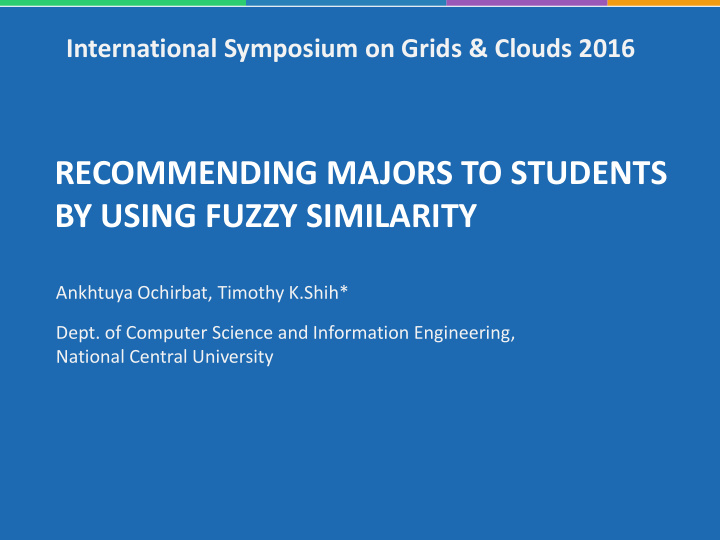



International Symposium on Grids & Clouds 2016 RECOMMENDING MAJORS TO STUDENTS BY USING FUZZY SIMILARITY Ankhtuya Ochirbat, Timothy K.Shih* Dept. of Computer Science and Information Engineering, National Central University
Outline • Introduction • How to help the students for suitable major choice? Problem statement • How to suggest the majors Top-N recommendation Data collection Fuzzy similarity • Experiment
Introduction • Even internet and computer are: everywhere growing rapidly price getting cheaper • But still there is considerable number of students in the world with no computer and no access to internet at home which makes the learning using internet for such groups is a difficult task.
Nomadic life
City life 5
Introduction • Young people in high schools and collages make critical decisions regarding what to study and which career path to pursue. • Many of them end up switching to other majors because of mismatching major choice and l ack of processing information through the professional study. Such changes are wasteful in time and resources and they produce emotional and economical stresses .
Problem Statement • In order to help students in major choice , it is essential to build the major recommendation system for the student with a capacity to meet all the needs where it provide direction and guidance to students in choosing a major that suits with their interest , learning style and personality . 7
Data Collection • Participants 107 Mongolian students of 11th grade participated in this study. • Occupational Information Network (O*NET): O*NET is a free online database containing hundreds of occupational definitions of work and worker characteristics, which are needed for the particular work. A version 19.0 of O*NET in MySQL is utilized in this study. Each occupations have 6 factors of vocational interests ranging from 1 to 7.
Data Collection • Measures Personality – Big Five Inventory (BFI) The BFI has the 44 items with responses made on a Likert scale format ranging from 1 = strongly disagree to 5 = strongly agree.
Data Collection • Measures Index of Learning style (ILS). self-scoring questionnaire with 44 items for measuring preferences on four dimensions. Active/Reflective Sensing/Intuitive Visual/Verbal Sequential/Global
Data Collection • Measures Vocational Interest: Holland code model (RIASEC) Holland code model has the 106-item with responses made on a 5- point scale (strongly dislike to strongly like). Holland code is divided six types.
Occupation Description - 974 12
Student info - 107 13
Architecture • Major Recommender System (MRS) is a website to assist students in exploring the majors. 14
Normalizing Data • we converted those scores into fuzzy values in range [0,1] that can be representing in graphical view which is a membership function using Trapezoid function. Figure 3. Membership function for interests of students and occupations 15
Fuzzy Similarity 16
System Interface 17
18
System Interface 19 Figure 2. Representations of BFI, LSI, and HC model’s Factors
Result 20
Thank you! 21
Recommend
More recommend